Using the GeoWEPP Model to Predict Water Erosion in Micro-Watersheds in the Brazilian Cerrado
Abstract
1. Introduction
2. Materials and Methods
2.1. Study Area
2.2. Soil Characterization and Soil Sampling
2.3. Soil Erosion Field Measurements
2.4. GeoWEPP Setup and Application
2.5. WEPP Input Data Preparation
2.5.1. Climate File
2.5.2. Topography and Land Cover
2.5.3. Soil File
2.5.4. Management File
2.5.5. Precipitation, Surface Runoff, Runoff Coefficient, and Soil Losses in Micro-Watersheds
2.6. Statistical Analysis and Modeling
3. Results and Discussion
3.1. Soil Characterization
3.2. WEPP Input Data Parameters
3.3. GeoWEPP Model Results
3.4. Future Directions for Sustainable Agricultural Development
4. Conclusions
Supplementary Materials
Author Contributions
Funding
Institutional Review Board Statement
Informed Consent Statement
Data Availability Statement
Acknowledgments
Conflicts of Interest
References
- Hernani, L.C.; de Freitas, P.L.; Pruski, F.F.; de Maria, I.C.; de Castro Filho, C.; Landers, J.N. A erosão e o seu impacto. In Uso Agrícola dos solos Brasileiros; Manzatto, C.V., de Freitas Junior, E., Peres, J.R.R., Eds.; Embrapa Solos: Rio de Janeiro, Brazil, 2002; pp. 47–60. Available online: https://ainfo.cnptia.embrapa.br/digital/bitstream/item/215162/1/A-erosao-e-seu-impacto-2002.pdf (accessed on 9 November 2022).
- Dechen, S.C.F.; Telles, T.S.; Guimarães, M.D.F.; Maria, I.C.D. Perdas e custos associados à erosão hídrica em função de taxas de cobertura do solo. Bragantia Camp. 2015, 74, 224–233. Available online: http://www.scielo.br/pdf/brag/v74n2/0006-8705-brag-74-2-224.pdf (accessed on 5 October 2018). [CrossRef]
- Ellen MacArthur Foundation. Cities and Circular Economy for Food, 2019 Report. Available online: http://www.ellenmacarthurfoundation.org/publications (accessed on 17 September 2022).
- Lal, R. Soil Erosion and Gaseous Emissions. Appl. Sci. 2020, 10, 2784. [Google Scholar] [CrossRef]
- Bhattarai, R.; Dutta, D. Estimation of Soil Erosion and Sediment Yield Using GIS at Catchment Scale. Water Resour. Manag. 2007, 21, 1635–1647. [Google Scholar] [CrossRef]
- Beven, K. Changing ideas in hydrology—The case of physically based models. J. Hydrol. 1989, 105, 157–172. [Google Scholar] [CrossRef]
- Grayson, R.B.; Moore, I.D.; McMahon, T.A. Physically-based hydrologic modeling: II. Is the concept realist? Water Resour. Res. 1992, 28, 2659–2666. [Google Scholar] [CrossRef]
- Tucci, C.E.M. Modelos Hidrológicos, 2nd ed.; Editora da UFRGS; Universidade Federal do Rio Grande do Sul: Porto Alegre, Brazil, 2005; pp. 1–678. ISBN 8570258232. [Google Scholar]
- Renschler, C.S.; Flanagan, D.C.; Engel, B.A.; Frankenberger, J.R. GeoWEPP—The Geo-spatial interface for the Water Erosion Prediction Project. In Proceedings of the 2002 ASAE Annual Meeting, Chicago, IL, USA, 18–31 July 2002; American Society of Agricultural and Biological Engineers: St. Joseph, MI, USA, 2002. [Google Scholar] [CrossRef]
- Jong Van Lier, Q.; Sparovek, G.; Flanagan, D.C.; Bloem, E.M.; Schnug, E. Runoff mapping using WEPP erosion model and GIS tools. Comput. Geosci. 2005, 31, 1270–1276. [Google Scholar] [CrossRef]
- Ferreira, A.M.; Silva, A.M.; Passos, C.A.; Valentino, C.H.; Gonçalves, F.A.; Menezes, P.H.B.J. Estimativa da erosão hídrica do solo pelo modelo Water Erosion Prediction Project na Sub-Bacia do Córrego do Gigante, sul de Minas Gerais. Eng. Sanit. Ambient. 2021, 26, 471–483. [Google Scholar] [CrossRef]
- Silva, A.M.; Mello, C.R.; Curi, N.; Oliveira, P.M. Simulação da variabilidade espacial da erosão hídrica em uma sub-bacia hidrográfica de Latossolos no sul de Minas Gerais. Rev. Bras. Ciênc. Solo 2008, 32, 2125–2134. [Google Scholar] [CrossRef]
- Cecílio, R.A.; Rodriguez, R.D.G.; Baena, L.G.N.; Oliveira, F.G.; Pruski, F.F. Aplicação dos modelos RUSLE e WEPP para a estimativa da erosão hídrica em microbacia hidrográfica de Viçosa (MG). Rev. Verde Agroecol. Desenvolv. Sustent. 2009, 4, 39–45. [Google Scholar] [CrossRef]
- Spera, S.A.; Cohn, A.S.; VanWey, L.K.; Mustard, J.F.; Rudorff, B.F.; Risso, J.; Adami, M. Recent cropping frequency, expansion, and abandonment in Mato Grosso, Brazil had selective land characteristics. Environ. Res. Lett. 2014, 9, 064010. [Google Scholar] [CrossRef]
- Ofstehage, A.; Nehring, R. No-till agriculture and the deception of sustainability in Brazil. Int. J. Agric. Sustain. 2021, 19, 335–348. [Google Scholar] [CrossRef]
- Fuentes-Llanillo, R.; Telles, T.S.; Junior, D.S.; de Melo, T.R.; Friedrich, T.; Kassam, A. Expansion of no-tillage practice in conservation agriculture in Brazil. Soil Tillage Res. 2021, 208, 104877. [Google Scholar] [CrossRef]
- Pandey, A.; Himanshu, S.K.; Mishra, S.K.; Singh, V.P. Physically based soil erosion and sediment yield models revisited. Catena 2016, 147, 595–620. [Google Scholar] [CrossRef]
- Amorim, R.S.S.; da Silva, D.D.; Pruski, F.F.; de Matos, A.T. Evaluation of the performance of the USLE, RUSLE and WEPP soil erosion models for different edaphoclimatic conditions in Brazil. Eng. Agric. 2010, 30, 1046–1059. [Google Scholar] [CrossRef]
- Magalhães, W.A.; Amorim, R.S.S.; Hunter, M.O.; Bocuti, E.D.; Dos Santos, T.G. Morphometric characteristics and hydrological dynamics in microbasins with different land uses of cerrado soils in Mato Grosso, Londrina (PR). Semin. Ciênc. Agrár. 2020, 41, 1909–1922. [Google Scholar] [CrossRef]
- Weska, R.K. Uma síntese do cretáceo superior mato-grossense. Rev. Geociênc. 2006, 25, 71–81. Available online: https://www.revistageociencias.com.br/geociencias-arquivos/25_1/7.pdf (accessed on 18 February 2023).
- Dos Santos, H.G.; Jacomine, P.T.; Dos Anjos, L.H.C.; De Oliveira, V.Á.; Lumbreras, J.F.; Coelho, M.R.; De Almeida, J.A.; de Araujo Filho, J.C.; De Oliveira, J.B.; Cunha, T.J.F. Brazilian Soil Classification System, 5th ed.; Embrapa: Brasília, Brazil, 2018; pp. 93–96. [Google Scholar]
- Bocuti, E.D. Condutividade Hidráulica Efetiva e Erodibilidade Entressulcos de Solos da Bacia do Rio das Mortes. Master’s Thesis, Universidade Federal de Mato Grosso, Cuiabá, Brazil, 2016; pp. 1–76. [Google Scholar]
- Nóbrega, R.L.B.; Guzha, A.C.; Torres, G.N.; Kovacs, K.; Lamparter, G.; Amorim, R.S.S.; Couto, E.; Gerold, G. Effects of conversion of native cerrado vegetation to pasture on soil hydro-physical properties, evapotranspiration and streamflow on the Amazonian agricultural frontier. PLoS ONE 2020, 12, e0179414. [Google Scholar] [CrossRef]
- Elliot, W.J. A Compendium of Soil Erodibility Data from WEPP Cropland Soil Field Erodibility Experiments 1987, 1988; U.S. Department of Agriculture, Agricultural Research Service: West Lafayette, IN, USA, 1989; pp. 1–291. [Google Scholar]
- Bocuti, E.D.; Amorim, R.S.S.; dos Santos, T.G.; Raimo, L.D.L.; Pereira, H.G. Interrill erodibility and its relationship with Cerrado soil attributes. Rev. Ciênc. Agrár. 2019, 42, 68–78. [Google Scholar] [CrossRef]
- Foster, G.R. Modeling the erosion process. In Hydrologic Modelling of Small Watersheds; Haan, C.T., Johnson, H.P., Brakensienk, D.L., Eds.; ASAE Monograph, ASAE: St. Joseph, MI, USA, 1982; pp. 296–380. [Google Scholar]
- ESRI 2016. ArcGIS Desktop: Release 10.4.1. Redlands, CA: Environmental Systems Research Institute. Available online: https://desktop.arcgis.com/en/quick-start-guides/10.4/arcgis-desktop-quick-start-guide.htm (accessed on 15 December 2016).
- Maalim, F.K.; Melesse, A.M.; Belmont, P.; Gran, K.B. Modeling the impact of land use changes on runoff and sediment yield in the Le Sueur watershed, Minnesota using GeoWEPP. Catena 2013, 107, 35–45. [Google Scholar] [CrossRef]
- Cligen. Agricultural Research Service, U.S. Department of Agriculture. Available online: https://www.ars.usda.gov/midwest-area/west-lafayette-in/national-soil-erosion-research/docs/wepp/cligen/ (accessed on 15 January 2017).
- Flanagan, D.C.; Nearing, M.A. USDA-Water Erosion Prediction Project Hillslope Profile and Watershed Model Documentation; NSERL Rep. No. 10; USDA-ARS National Soil Erosion Research Laboratory: West Lafayette, IN, USA, 1995. Available online: https://www.ars.usda.gov/midwest-area/west-lafayette-in/national-soil-erosion-research/docs/wepp/wepp-model-documentation/ (accessed on 3 March 2017).
- Admas, M.; Melesse, A.M.; Abate, B.; Tegegne, G. Soil Erosion, Sediment Yield, and Runoff Modeling of the Megech Watershed Using the GeoWEPP Model. Hydrology 2022, 9, 208. [Google Scholar] [CrossRef]
- Parente, L.; Mesquita, V.; Miziara, F.; Baumann, L.; Ferreira, L. Assessing the pasturelands and livestock dynamics in Brazil, from 1985 to 2017: A novel approach based on high spatial resolution imagery and Google Earth Engine cloud computing. Remote Sens. Environ. 2019, 232, 111301. [Google Scholar] [CrossRef]
- Campos, M.O.; Cerri, C.E.P.; La Scala, N. Atmospheric CO2, soil carbon stock and control variables in managed and degraded pastures in central Brazil. Remote Sens. Appl. Soc. Environ. 2022, 28, 100848. [Google Scholar] [CrossRef]
- Ferreira, M.M.; Fernandes, B.; Curi, N. Influencia da mineralogía da fração argila nas propriedades físicas de Latossolos da região sudeste do Brasil. Rev. Bras. Cienc. Solo 1999, 23, 515–524. [Google Scholar] [CrossRef]
- Alcantara, G.H. Erodibilidade em Sulcos e Tensão Cisalhante Crítica de Latossolos com Diferentes Teores de Óxidos de Ferro. Master’s Thesis, Faculdade Ciências Agrárias e Veterinárias, Universidade Estadual Paulista, São Paulo, Brazil, 2018; 71p. [Google Scholar]
- Nunes, M.C.M.; Cassol, E.A. Estimativa da erodibilidade em entressulcos de latossolos do Rio Grande do Sul. Rev. Bras. Cienc. Solo 2008, 32, 2839–2845. [Google Scholar] [CrossRef]
- Alves, M.A.B.; de Souza, A.P.; de Almeida, F.T.; Hoshide, A.K.; Araújo, H.B.; da Silva, A.F.; de Carvalho, D.F. Impact of land use on soil erosion in agricultural frontier areas in the Cerrado-Amazon ecotone, Brazil. Sustainability, 2023; submitted. [Google Scholar]
- González-Arqueros, M.L.; Mendoza, M.E.; Vázquez-Selem, L. Human impact on natural systems modeled through soil erosion in GeoWEPP: A comparison between pre-Hispanic periods and modern times in the Teotihuacan Valley (Central Mexico). Catena 2017, 149 Pt 1, 505–513. [Google Scholar] [CrossRef]
- Nóbrega, R.L.B.; Guzha, A.C.; Lamparter, G.; Amorim, R.S.S.; Couto, E.G.; Hughes, H.J.; Gerold, G. Impacts of land-use and land-cover change on stream hydrochemistry in the Cerrado and Amazon biomes. Sci. Total Environ. 2018, 635, 259–274. [Google Scholar] [CrossRef] [PubMed]
- Nearing, M.A.; Deer-Ascough, L.; Laflen, J.M. Sensitivity analysis of the WEPP hillslope-profile erosion model. Trans. ASAE 1990, 33, 839–849. [Google Scholar] [CrossRef]
- Bocuti, E.D.; Amorim, R.S.S.; Raimo, L.A.D.L.D.; Magalhães, W.D.A.; de Azevedo, E.C. Effective hydraulic conductivity and its relationship with the other attributes of Cerrado soils. Rev. Bras. Eng. Agric. Ambient. 2020, 24, 357–363. [Google Scholar] [CrossRef]
- Pissarra, T.C.T.; Politano, W.; Ferraudo, A.S. Avaliação de características morfométricas na relação solo-superfície da bacia hidrográfica do Córrego Rico, Jaboticabal (SP). Rev. Bras. Cienc. Solo 2004, 28, 297–305. [Google Scholar] [CrossRef]
- Nearing, M.A. Why soil erosion models over-predict small soil losses and under-predict large soil losses. Catena 1998, 32, 15–22. [Google Scholar] [CrossRef]
- Tiwari, A.K.; Risse, L.M.; Nearing, M.A. Evaluation of WEPP and its comparison with USLE and RUSLE. Trans. ASAE 2000, 43, 1129–1135. [Google Scholar] [CrossRef]
- Kinnell, P.I.A. A comparison of the abilities of the USLE-M, RUSLE2 and WEPP to model event erosion from bare fallow areas. Sci. Total Environ. 2017, 596–597, 32–42. [Google Scholar] [CrossRef]
- Gonçalves, F.A. Validação do Modelo WEPP na Predição de Erosão Hídrica para Condição Edafoclimática da Região de VIÇOSA-MG. Ph.D. Thesis, Universidade Federal de Viçosa, Viçosa, Brazil, 2007; pp. 1–116. Available online: https://www.locus.ufv.br/bitstream/123456789/629/1/texto%20completo.pdf (accessed on 31 January 2023).
- Amorim, R.S.S. Avaliação dos Modelos de Predição da Erosão Hídrica USLE, RUSLE e WEPP para Condições Edafoclimáticas Brasileiras. Ph.D. Thesis, Universidade Federal de Viçosa, Viçosa, Brazil, 2003; pp. 1–120. Available online: https://www.locus.ufv.br/bitstream/123456789/9620/1/texto%20completo.pdf (accessed on 31 January 2023).
- Guerra, A.J.T.; Fullen, M.A.; Jorge, M.D.C.O.; Alexandre, S.T. Soil Erosion and Conservation in Brazil. Anu. Inst. Geociênc. 2014, 37, 81–91. [Google Scholar] [CrossRef]
- Oliveira, P.T.S.; Godoi, R.D.F.; Colman, C.B.; Motta, J.S.; Sone, J.S.; Almagro, A. Agricultural Land Degradation in Brazil. In The Handbook of Environmental Chemistry; Springer: Berlin/Heidelberg, Germany, 2022; pp. 1–31. [Google Scholar] [CrossRef]
- Lins, C.M.T.; de Souza, E.R.; Souza, T.E.M.d.S.; Paulino, M.K.S.S.; Monteiro, D.R.; Júnior, V.S.D.S.; Dourado, P.R.M.; Junior, F.E.D.A.R.; da Silva, Y.J.A.; Schaffer, B. Influence of vegetation cover and rainfall intensity on soil attributes in an area undergoing desertification in Brazil. Catena 2023, 221, 106751. [Google Scholar] [CrossRef]
- Nóbrega, R.L.B.; Ziembowicz, T.; Torres, G.N.; Guzha, A.C.; Amorim, R.S.S.; Cardoso, D.; Johnson, M.S.; Santos, T.G.; Couto, E.; Gerold, G. Ecosystem services of a functionally diverse riparian zone in the Amazon-Cerrado agricultural frontier. Glob. Ecol. Conserv. 2020, 21, e00819. [Google Scholar] [CrossRef]
- Bouramtane, T.; Hilal, H.; Rezende-Filho, A.T.; Bouramtane, K.; Barbiero, L.; Abraham, S.; Valles, V.; Kacimi, I.; Sanhaji, H.; Torres-Rondon, L.; et al. Mapping Gully Erosion Variability and Susceptibility Using Remote Sensing, Multivariate Statistical Analysis, and Machine Learning in South Mato Grosso, Brazil. Geosciences 2022, 12, 235. [Google Scholar] [CrossRef]
- Borella, D.R.; de Souza, A.P.; de Almeida, F.T.; de Abreu, D.C.; Hoshide, A.K.; Carvalho, G.A.; Pereira, R.R.; da Silva, A.F. Dynamics of Sediment Transport in the Teles Pires River Basin in the Cerrado-Amazon, Brazil. Sustainability 2022, 14, 16050. [Google Scholar] [CrossRef]
- Polidoro, J.C.; de Freitas, P.L.; Hernani, L.C.; dos Anjos, L.H.C.; Rodrigues, R.D.A.R.; Cesário, F.V.; de Andrade, A.G.; Ribeiro, J.L. Potential impact of plans and policies based on the principles of conservation agriculture on the control of soil erosion in Brazil. Land Degrad. Dev. 2021, 32, 3457–3468. [Google Scholar] [CrossRef]
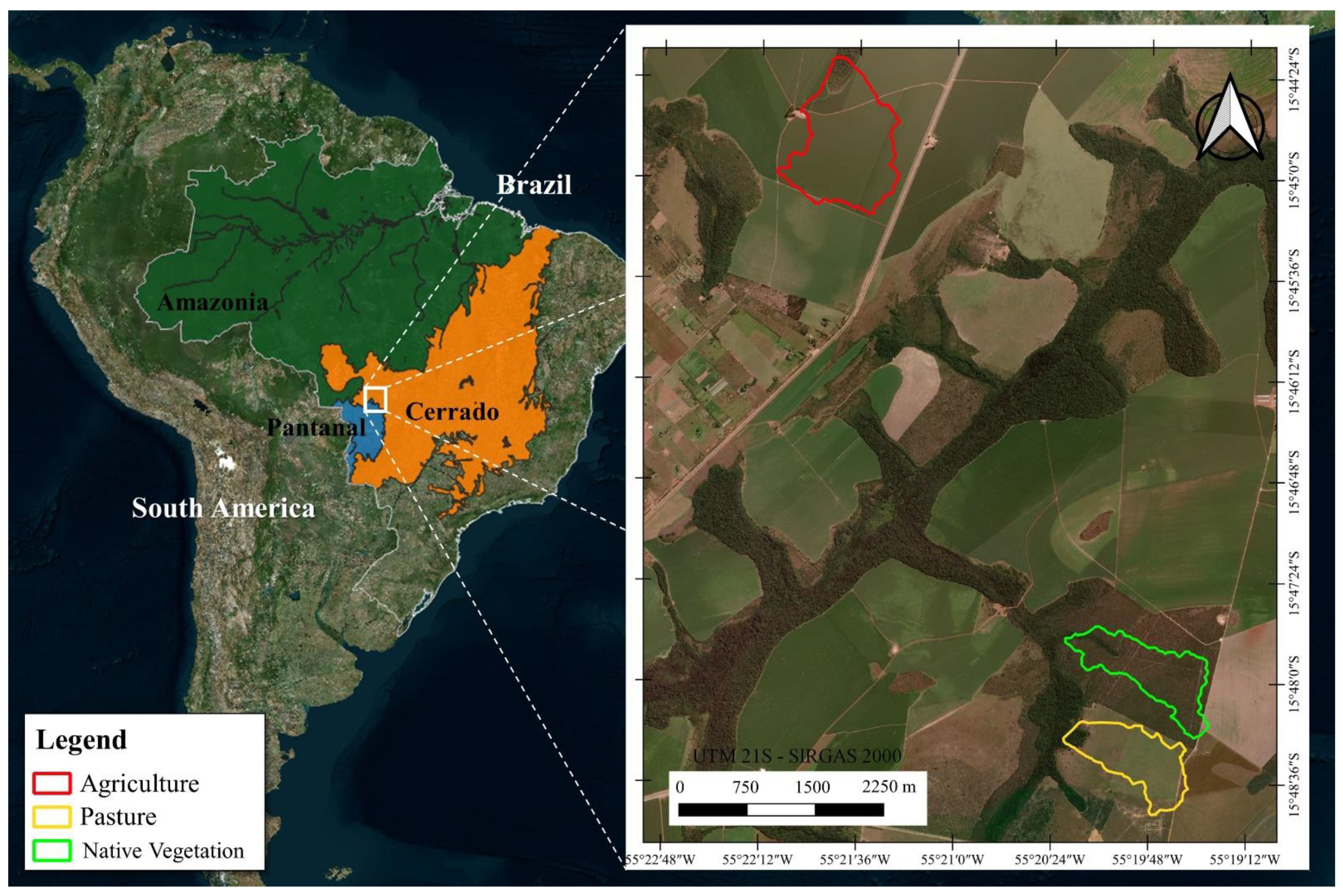
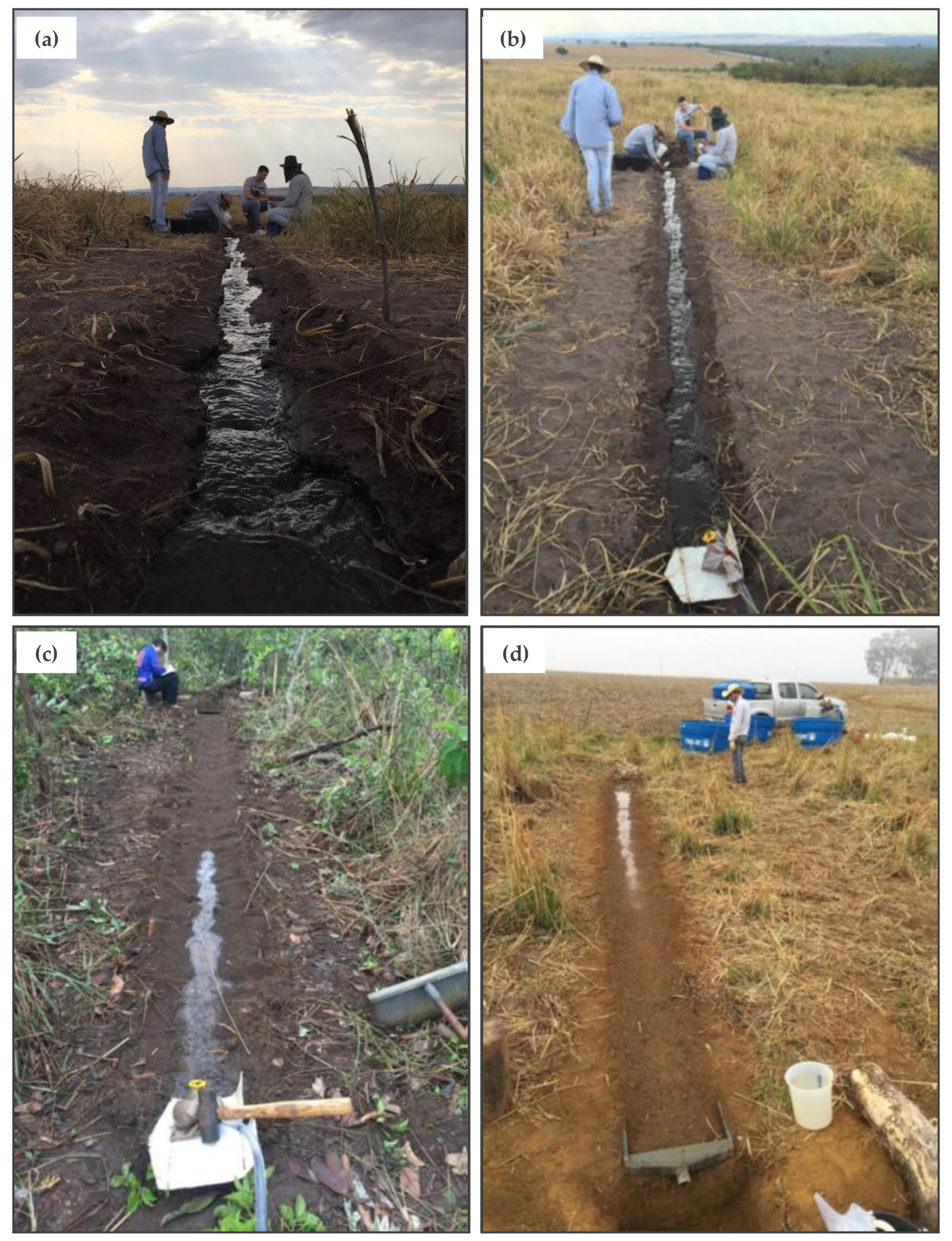
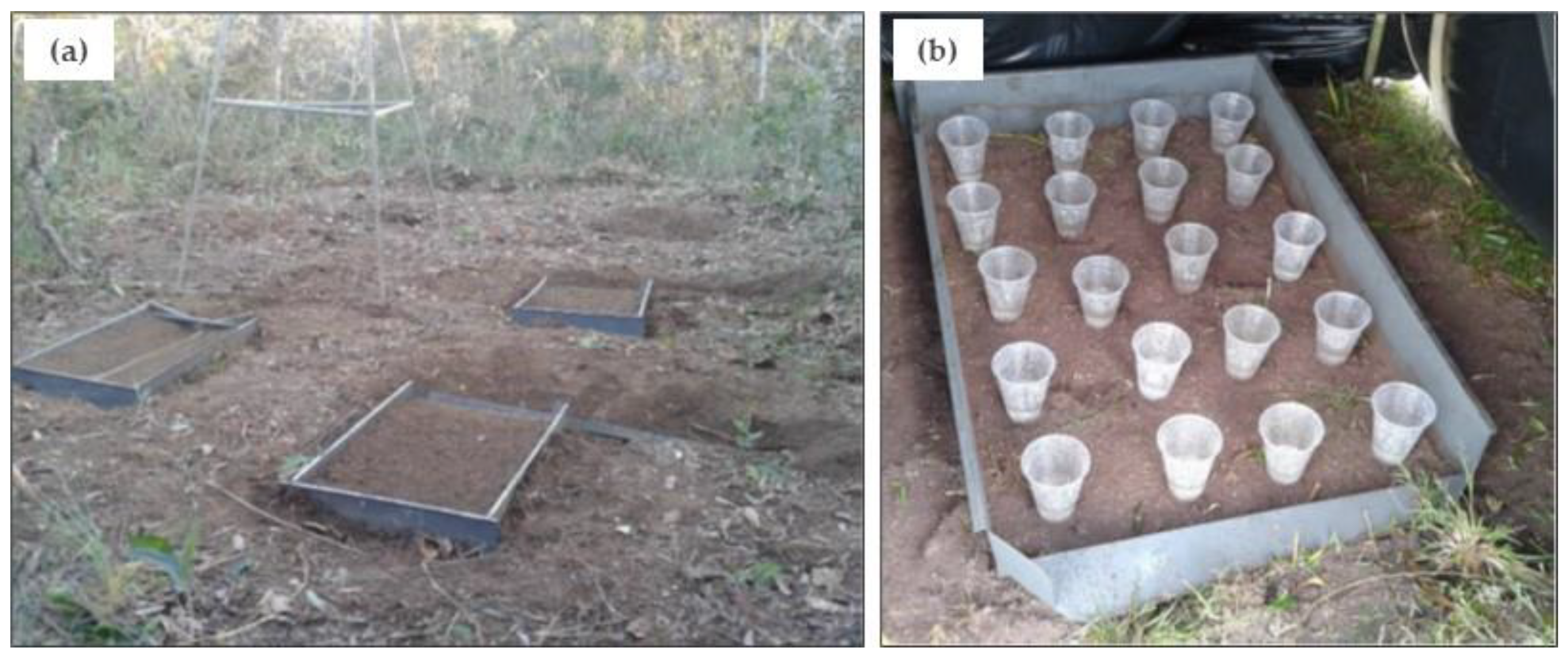
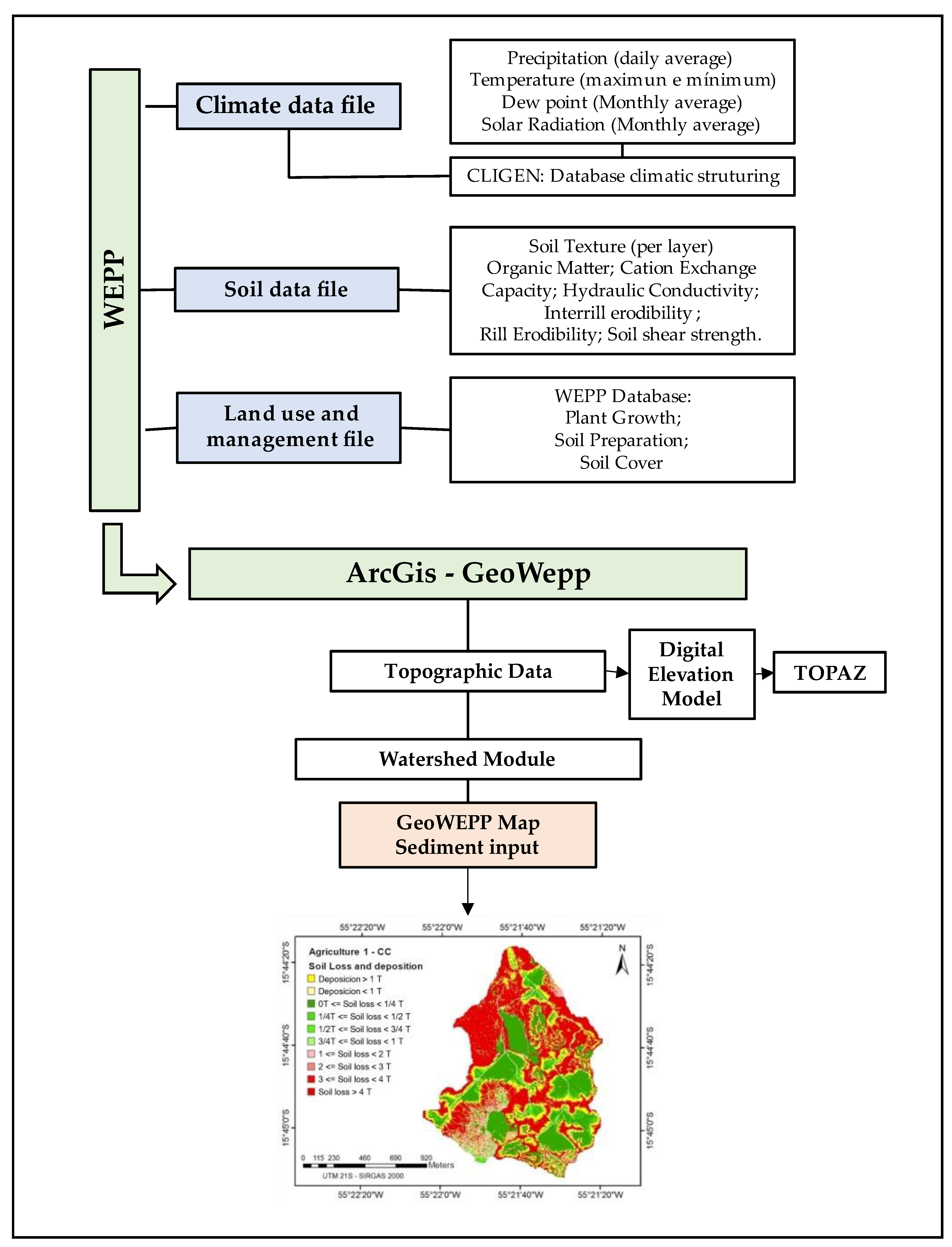
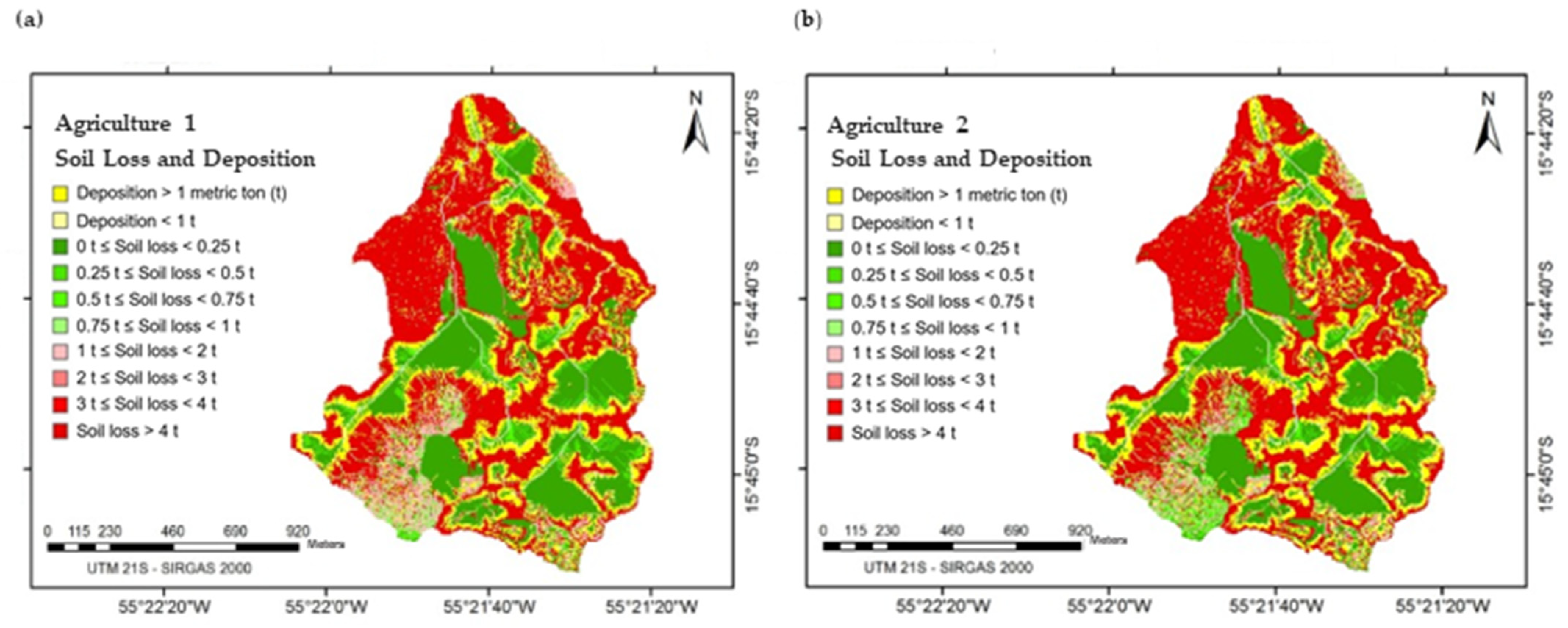


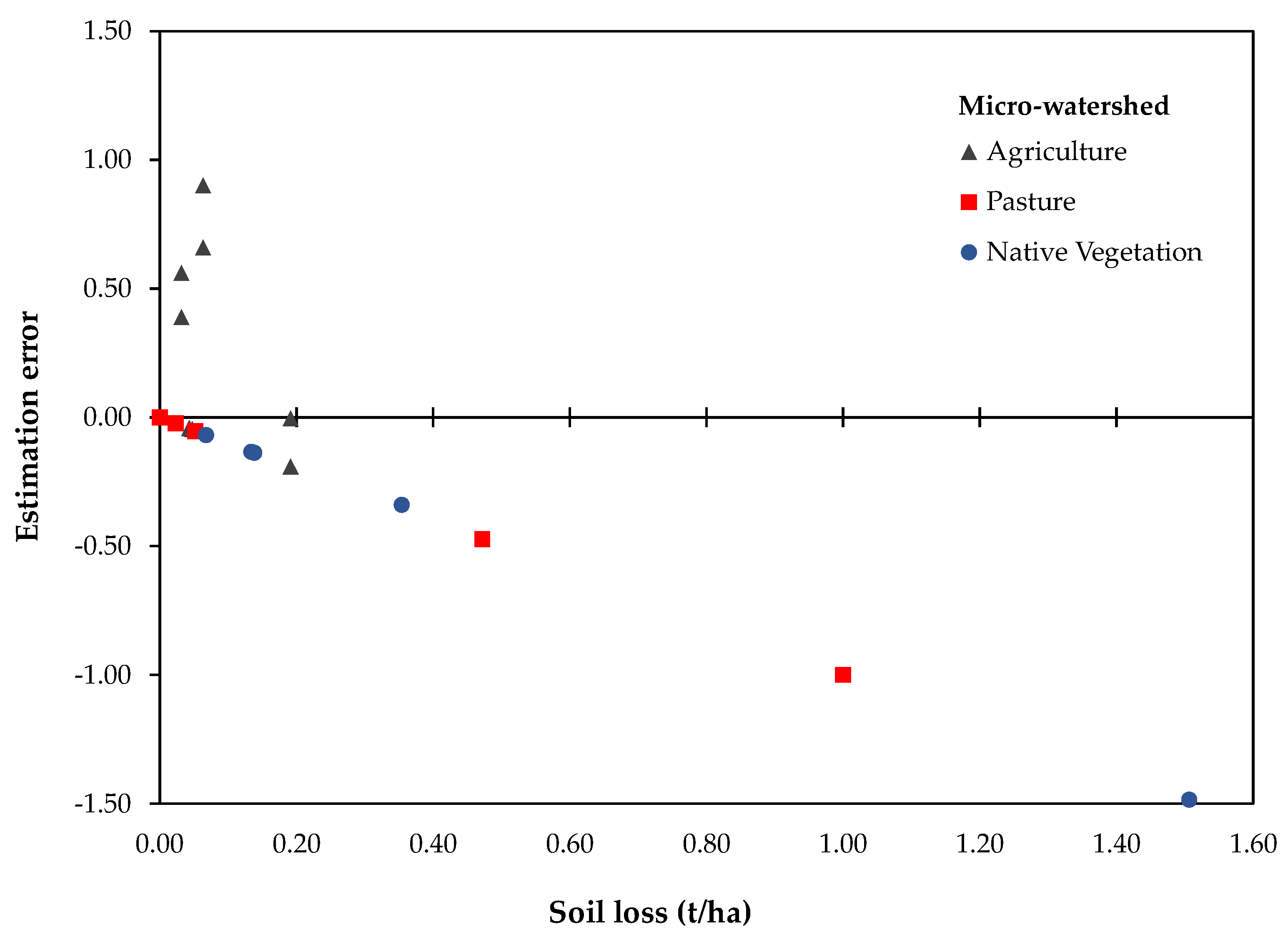
| Soil Property | Unit | Agri- Culture 1 | Agri- Culture 2 | Pasture 1 | Pasture 2 | Native Vegetation |
|---|---|---|---|---|---|---|
| Clay | grams (g)/kilogram (kg) | 518 | 512 | 31 | 496 | 140 |
| Sand | g/kg | 300 | 355 | 926 | 946 | 748 |
| Total organic carbon | g/kg | 33.80 | 29.40 | 0.56 | 0.40 | 14.40 |
| Total porosity | % | 56.60 | 61.71 | 40.23 | 43.54 | 51.51 |
| Aggregate stability index (ASI) | % | 93.45 | 86.93 | 78.59 | 26.59 | 96.06 |
| Mineralogy | n/a | Gibbsite Quartz Kaolinite | Gibbsite Quartz Kaolinite | Gibbsite Quartz | Gibbsite Quartz | Gibbsite Quartz Goethite |
| Slope | % | 5.33 | 1.60 | 13.6 | 3.70 | 5.55 |
| Micro-Watershed Land Cover | Hydraulic Conductivity (Ke) | Interrill Soil Erodibility (Ki) | Rill Soil Erodibility (Kr) | Runoff Critical Shear Stress (τc) |
|---|---|---|---|---|
| Millimeters/Hour | Kilograms/(m × m3) | Seconds/ Meter | Newtons/ Square Meter | |
| Agriculture 1 | 30.63 ± 6.76 | 2.44 × 10−5 ± 0.83 × 104 | 0.2781 | 0.001483 |
| Agriculture 2 | 24.49 ± 3.12 | 13.2 × 10−5 ± 18.2 × 104 | 0.1927 | 0.042942 |
| Pasture 1 | 81.52 ± 15.80 | 1.56 × 10−5 ± 2.04 × 104 | 5.2539 | 0.000949 |
| Pasture 2 | 109.94 ± 19.34 | 2.47 × 10−5 ± 4.14 × 104 | 11.2723 | 0.000428 |
| Native vegetation | 48.31 ± 13.41 | 0.86 × 10−5 ± 0.21 × 104 | 1.4383 | 0.002991 |
| Micro-Watershed Land Cover | Observed | Simulated by GeoWEPP Model | ||||
|---|---|---|---|---|---|---|
| Total Water Depth Precip-itated (Wdp) | Surface Runoff (SR) | SR Coefficient | Soil Loss | Soil Loss w/NO Calibration Parameters | Soil Loss w/Calibration Parameters | |
| millimeters/year | % | metric tons/hectares/year | metric tons/hectares/year | metric tons/hectares/year | ||
| Agriculture 1 | 1640.8 | 141.3 | 8.61 | 0.11 | 2.71 | 5.78 |
| Agriculture 2 | 2.42 | 6.16 | ||||
| Pasture 1 | 1616.8 | 477.8 | 29.55 | 0.06 | 0.28 | 0.03 |
| Pasture 2 | 0.44 | 0.03 | ||||
| Native vegetation | 1579.3 | 361.8 | 22.91 | 0.10 | 0.21 | 0.10 |
| Micro-Watershed | Statistical Parameters | ||
|---|---|---|---|
| Root Mean Squared Error (RMSE) | Willmott Concordance Index (d) | Nash- Sutcliffe (NS) | |
| Agriculture | 0.12 | 0.27 | −3.38 |
| Pasture | 0.48 | 0.59 | −0.56 |
| Native vegetation | 0.68 | 0.44 | −0.59 |
Disclaimer/Publisher’s Note: The statements, opinions and data contained in all publications are solely those of the individual author(s) and contributor(s) and not of MDPI and/or the editor(s). MDPI and/or the editor(s) disclaim responsibility for any injury to people or property resulting from any ideas, methods, instructions or products referred to in the content. |
© 2023 by the authors. Licensee MDPI, Basel, Switzerland. This article is an open access article distributed under the terms and conditions of the Creative Commons Attribution (CC BY) license (https://creativecommons.org/licenses/by/4.0/).
Share and Cite
Magalhães, W.d.A.; Amorim, R.S.S.; Hunter, M.O.; Bocuti, E.D.; Di Loreto Di Raimo, L.A.; da Silva, W.M.; Hoshide, A.K.; de Abreu, D.C. Using the GeoWEPP Model to Predict Water Erosion in Micro-Watersheds in the Brazilian Cerrado. Sustainability 2023, 15, 4711. https://doi.org/10.3390/su15064711
Magalhães WdA, Amorim RSS, Hunter MO, Bocuti ED, Di Loreto Di Raimo LA, da Silva WM, Hoshide AK, de Abreu DC. Using the GeoWEPP Model to Predict Water Erosion in Micro-Watersheds in the Brazilian Cerrado. Sustainability. 2023; 15(6):4711. https://doi.org/10.3390/su15064711
Chicago/Turabian StyleMagalhães, Wellington de Azambuja, Ricardo Santos Silva Amorim, Maria O’Healy Hunter, Edwaldo Dias Bocuti, Luis Augusto Di Loreto Di Raimo, Wininton Mendes da Silva, Aaron Kinyu Hoshide, and Daniel Carneiro de Abreu. 2023. "Using the GeoWEPP Model to Predict Water Erosion in Micro-Watersheds in the Brazilian Cerrado" Sustainability 15, no. 6: 4711. https://doi.org/10.3390/su15064711
APA StyleMagalhães, W. d. A., Amorim, R. S. S., Hunter, M. O., Bocuti, E. D., Di Loreto Di Raimo, L. A., da Silva, W. M., Hoshide, A. K., & de Abreu, D. C. (2023). Using the GeoWEPP Model to Predict Water Erosion in Micro-Watersheds in the Brazilian Cerrado. Sustainability, 15(6), 4711. https://doi.org/10.3390/su15064711







